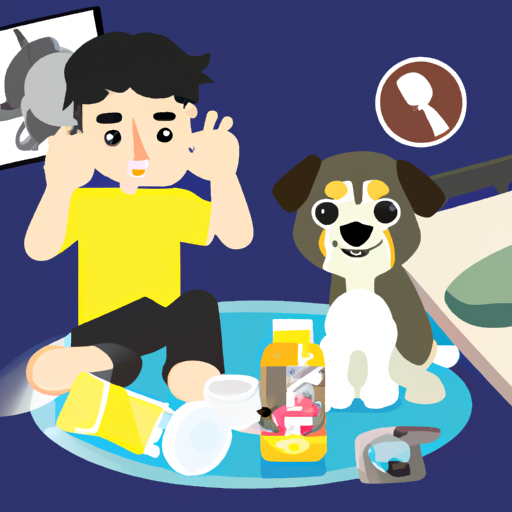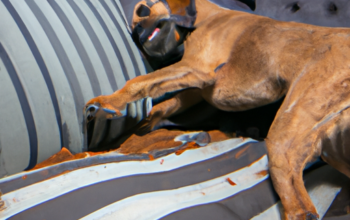Imagine you’re playing fetch with your beloved canine companion when you notice something’s not quite right – his penis is stuck outside its sheath and won’t retract.
You’ve just identified a potentially serious condition known as paraphimosis. It’s crucial to understand this condition, recognize its symptoms, and know how to provide initial at-home remedies before seeking veterinary care.
Throughout this article, we’ll guide you on ways to prevent future occurrences of paraphimosis in your furry friend. This knowledge can spare both you and your pet from unnecessary discomfort or distress.
Keep in mind that while some treatment can be managed at home, severe cases require professional medical intervention. Let’s walk through this journey together so you are well-equipped if such an unfortunate situation arises.
Understanding the Condition
It’s crucial to grasp what paraphimosis in dogs actually is before diving into our at-home remedies. Paraphimosis, rooted in Canine Anatomy Basics, is a condition where a dog’s penis remains outside the prepuce or ‘sheath’ for extended periods without the ability to retract. This situation can lead to severe complications if not addressed promptly, including infection and necrosis.
Understanding the potential Disease Transmission Risks associated with paraphimosis helps you comprehend why it’s essential to tackle this problem urgently. If your dog interacts with others while having an exposed penis, there’s a risk of transmitting infections. However, remember that diagnosing and treating conditions like these should ideally be under professional supervision as home remedies might not always suffice.
Recognizing the Symptoms
Did you know that nearly 20% of male canines experience symptoms such as excessive licking of the genital area, difficulty urinating, or apparent discomfort when sitting? These could be signs of a condition known as paraphimosis.
When it comes to canine hygiene, it’s crucial for pet owners to be vigilant and observant. Dogs with this condition may also display redness and swelling in the penis area. Additionally, they might show signs of distress like pacing or whining due to the pain caused by paraphimosis.
Symptom misinterpretation can lead to delays in treatment; therefore, understanding these signs is vital. If your dog exhibits any of these symptoms persistently, consult a vet immediately. While some home remedies exist for mild cases, severe paraphimosis requires professional intervention.
Initial At-Home Remedies
While you’re likely eager to ease your furry friend’s discomfort, there are some initial at-home remedies you can try before heading to the vet.
Homeopathic solutions like calendula ointment or aloe vera gel can provide immediate relief by reducing inflammation and promoting healing. If your dog allows it, gently pull back the foreskin and apply these remedies directly onto the affected area.
Remember to keep an eye on their water intake and ensure they’re staying hydrated. Also, limit their physical activity until the condition improves.
However, while these home treatments may help alleviate symptoms temporarily, they aren’t permanent solutions for paraphimosis in dogs. It’s crucial to seek veterinary attention if symptoms persist or worsen despite your efforts at home.
Preventing Future Instances
Prevention is always better than cure, especially when it comes to your beloved pet’s health. To prevent future instances of paraphimosis in your dog, consider making dietary adjustments and maintaining regular grooming practices.
A balanced diet helps maintain overall good health, potentially reducing the risk of recurring conditions like paraphimosis. Include plenty of fresh fruits and vegetables in your pet’s meals for essential vitamins and minerals.
In addition to a healthy diet, regular grooming plays a significant role too. Regularly cleaning around your dog’s genital area can help spot early signs of paraphimosis or avoid it altogether by preventing any irritation or infection that might trigger this condition.
Remember, consistent care significantly reduces the chances of facing such unpleasant situations with your furry friend again.
When to Seek Veterinary Care
It’s crucial to know when it’s time to hustle off to the vet. Despite your best efforts, some cases of paraphimosis in dogs can’t be resolved at home and require veterinary intervention.
Emergency indicators that warrant immediate attention include:
| Condition | Description | Action |
|---|---|---|
| Persistent protrusion | Penis remains outside for extended period despite attempts to reposition it. | Visit Vet ASAP |
| Swelling or discoloration | Unusual colors or increased size on the penis area. | Immediate Vet Attention |
| Painful urination or inability to urinate | Dog shows discomfort during pee or can’t pee at all. | Rush To Vet |
If you notice any of these signs, don’t try further home treatments. Instead, get your dog professional help right away.
Frequently Asked Questions
How does the breed of my dog influence the risk of paraphimosis?
Stepping out of the time machine, you’ll find breed susceptibility and genetic factors do influence your dog’s risk of paraphimosis. Some breeds have more predisposition due to their particular physical characteristics and genetics.
What is the average age at which dogs typically experience paraphimosis?
Paraphimosis symptoms can appear in dogs of any age, but it’s more common in older males. It’s crucial to consult a vet for treatment options as soon as you notice signs of this condition.
Can female dogs also suffer from paraphimosis?
While you might think female dogs could also suffer from paraphimosis due to hormonal influences, it’s not the case. Given the female canine anatomy, they’re not susceptible to this condition as it affects male genitalia exclusively.
Are there long-term health implications if my dog has had paraphimosis?
Yes, untreated paraphimosis can lead to complications such as tissue death and infection. However, with prompt treatment options like manual retraction or surgery, you can prevent these long-term health implications in your dog.
Can neutering my dog prevent the occurrence of paraphimosis?
Neutering your dog can indeed help prevent paraphimosis. The hormonal changes induced by neutering often reduce sexual behaviors that can lead to this condition, showcasing one of the many benefits of neutering.
Conclusion
Like a watchful guardian, you’ve learned to recognize and manage your dog’s paraphimosis at home. You now know the importance of preventive measures and when professional help is needed.
Remember, swift action can make all the difference – just like nipping a problem in the bud before it fully blossoms. Your knowledge empowers you to ensure your furry friend’s health and happiness.



